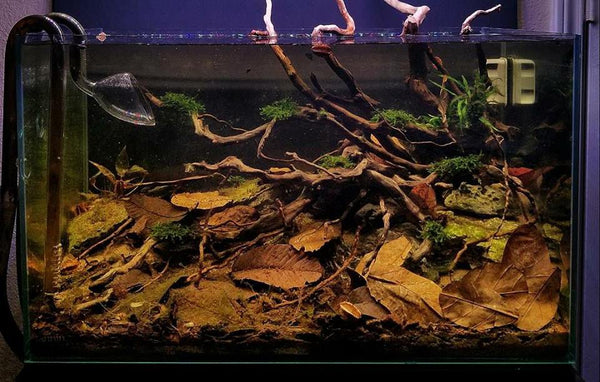- Continue Shopping
- Your Cart is Empty
The tangle of Spider Wood...
When it comes to creating hardscape in our aquariums, we tend to fall in love with a few varieties of wood. I mean, sure, we are always looking for different varieties, yet we seem to settle on certain types with incredible predictability. And there is absolutely nothing wrong with that!
One of the most consistently popular wood types in our hobby is what is known as "Spider Wood." It has a most unusual root-like configuration, which lends itself well to all sorts of aquascaping applications.

Now, I've always liked this stuff, and we've pretty much always sold this stuff as "Hand-Selected Pieces" (ie; random ones we pic FOR you!), which are just as good as when we used to sell them as WYSIWYG...And better for you, because it costs less when we don't have to photograph each piece! I mean, they ALL pretty much have unique attributes and almost every piece looks good from one or more angles.
You can't really go wrong.
And it "plays well with other materials- like Senggani Root, as we've demonstrated in our most recent tank.

You almost can't go wrong, really. Even with a guy like me selecting for you!

Now, I'll be the first to tell you that "Spider Wood", although stupidly easy to work with, has its own set of quirks. It has some really gnarled shapes- which is awesome, but you need to think about it if you're trying to use a few larger pieces in your 'scape. Often the pieces are rather challenging to "fit together" if your goal is to make it look like they are part of one "organic formation", if you will, so you really have to use some forward vision if that's your goal and you're using the larger-sized pieces.
The "nano-sized" ones are ideal for this type of project.

I mean, if you look closely at a lot of displays that use this wood, they look sort of like a bunch of little peices all stuck together. Which, I suppose, is part of the "charm" of the stuff. You have to envision it after a month, covered with a "patina" of biocover, surrounded by decomposing botanical botanicals...

My understanding that what the aquatic trade refers to as "Spider Wood" is the roots of Rhododendron (aka Azalea), a genus of over a thousand woody plants found in Asia and North America. Like everything else in the aquarium hardscape trade, the exact species or origins are kept shrouded in a sort of deliberate mystery. That being said, it's no mystery why the stuff is popular! It looks pretty cool...once you figure out how to use it!

And, as an added "bonus", this stuff releases a lot of nice, water-tintitng tannins...something that freaks the f--- out of most hardcore aquascapers (much to my sadistic delight, as you know), but something that our tribe just loves! Oh, and the plant (and I think likely by extension, the roots) is known to offer "..possible anti-inflammatory and hepatoprotective activities" which may be due to the antioxidant effects of flavonoids or other phenolic compounds and saponins the plant contains...
If you recall, some of these same substances are known to occur in Catappa leaves, and there are documented fish health benefits of catappa, validated in scientific research.
SO...hmm...maybe?

Oh, and it does tend to recruit a fair amount of gooey fungal/biofilm growth shortly after submersion, often to the horror of the unaware...So, if ever there were a candidate for "pre-soaking" wood before using in the aquarium, "Spider Wood" is it. Granted, this growth will usually subside after a few weeks of submersion, and some well-timed scrubbing with a soft-bristled brush.
Holy detour, Batman! Okay, so back to the scaping thing...
It's relatively lightweight. REALLY gnarled in appearance...and pretty much perfect for many types of aquascaping ideas!

And that's about alI I have to say about THAT!
Stay creative. Stay inspired. Stay diligent. Stay curious...
And Stay Wet.
Scott Fellman
Tannin Aquatics
3 Responses
Jo
I see this information is a few years old,, but aren’t We all.. I really got some good information from this page and I’ll search for more from You.. Thank You Very Much..
Jo Gillean
Scott Fellman
Great question…ANd I couldn’t tell you. I’ve had some pieces of Spider wood last for several years. The reality, as you mention, is that all terrestrial materials break down in water over time…Just how long that might be is anyones guess, and there are lots of possible variables, like temperature, pH, etc. that likely impact its longevity underwater…oh, and the presence of fishes like Plecos, who rasp constantly at it…
-Scott
Denis
So, how long will it last in the aquarium before it turns to mush? It is organic, and organics break down in water. How long will it last?
Thanks






Scott Fellman
Author